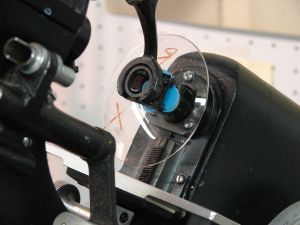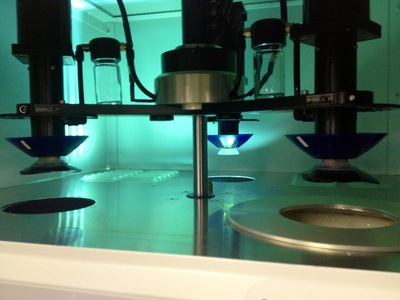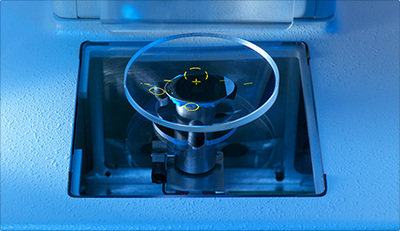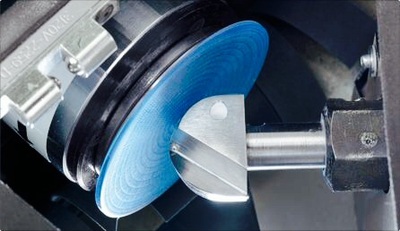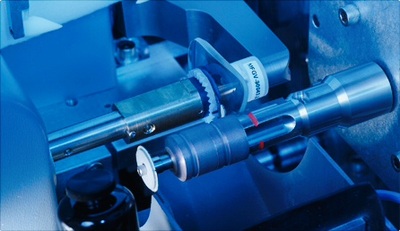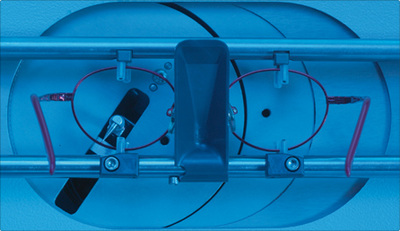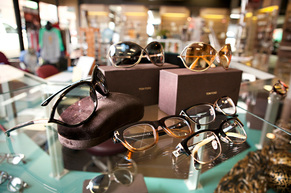Your Prescription
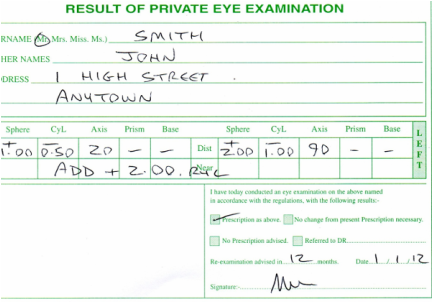
When you look closely at your presciption for eyeglasses, you will notice numbers listed under OD and OS headings. These are Latin abbreviations for right eye (oculus dexter, OD) and left eye (oculus sinister, OS). Occasionally you will see the notation for OU (oculi uterque), which means both eyes, right and left.
The further away from zero the number on your presciption is, the worse your eyesight and the stronger the correction needed. A plus sign (+) in front of the numbers means you are hyperopic, or farsighted. A minus (-) sign means you are myopic, or nearsighted. The numbers are recorded in diopters and is often abbreviated as D. The least amont of correction your doctor will prescribe is a 12th (.12) of a diopter, like $0.12 of a dollar. For example, If your prescription states -1.00, you have one diopter of nearsightedness, or a correction similiar to one dollar. This would be a mild amount of nearsightedness. If you are -5.00, you have 5 diopters of nearsightedness or an equivalence similiar to $5.00. This would be more nearsightedness, and would require much stronger lenses. Similiarly, +1.00 would be a small amount of farsightedness and +5.00 would be much more.
If your eye is astigmatic (two different corneal curves), there will be three numbers in your prescription, sphere, cylinder, and axis. The sphere portion reveals how much nearsighted or farsighted correction is needed, as discussed above. The cylinder reveals how much astigmatism correction is needed. The axis determines at what degree the the cylinder correction should be placed.
The add power, or bifocal power, is the amount of additional correction that is needed for close up, or near vision. This is always found in multifocal lenses.
The further away from zero the number on your presciption is, the worse your eyesight and the stronger the correction needed. A plus sign (+) in front of the numbers means you are hyperopic, or farsighted. A minus (-) sign means you are myopic, or nearsighted. The numbers are recorded in diopters and is often abbreviated as D. The least amont of correction your doctor will prescribe is a 12th (.12) of a diopter, like $0.12 of a dollar. For example, If your prescription states -1.00, you have one diopter of nearsightedness, or a correction similiar to one dollar. This would be a mild amount of nearsightedness. If you are -5.00, you have 5 diopters of nearsightedness or an equivalence similiar to $5.00. This would be more nearsightedness, and would require much stronger lenses. Similiarly, +1.00 would be a small amount of farsightedness and +5.00 would be much more.
If your eye is astigmatic (two different corneal curves), there will be three numbers in your prescription, sphere, cylinder, and axis. The sphere portion reveals how much nearsighted or farsighted correction is needed, as discussed above. The cylinder reveals how much astigmatism correction is needed. The axis determines at what degree the the cylinder correction should be placed.
The add power, or bifocal power, is the amount of additional correction that is needed for close up, or near vision. This is always found in multifocal lenses.
How Vision Works

The eye is a complex organ that works very similiar to that of a camera by focusing light rays and forming images. On the surface of the eye is the cornea, a thin, spherical layer of tissue that provides a clear window for light to pass through. In a normal healthy eye, the cornea bends or refracts light rays so that they focus precisely on the retina in the back of the eye. When light enters the eye it first passes through the cornea, then the aqueous humor, the crystalline lens, the vitreous humor and then ultimately it reaches the retina.
Located beneath the cornea is the iris, the colored part of the eye. In the center of the iris is thepupil. The iris functions like a shutter, adjusting pupil size to control the amount of light entering the eye.
Behind the iris is the crystalline lens, which works together with the cornea and the vitreous to focus light. Like a lens in a camera, the lens adjusts light rays as vision shifts between up close and distant objects in a process called accomodation.
Light is then dispersed through the vitreous, a gelatin substance that fills most of the eye and gives it its shape.
The back of the eye is lined with a thin layer of tissue containing millions of photoreceptor cells called rods and cones that are very light sensitive. The rods handle vision in low light while the cones handle color vision and detail. Once the light rays reach the retina, the light rays are focused into an inverted or upside down image. In the center of the retina is the macula. The macula is responsible for clear central vision. The retina converts the image into an electrical signal that travels down the optic nerve and to the brain.
Located beneath the cornea is the iris, the colored part of the eye. In the center of the iris is thepupil. The iris functions like a shutter, adjusting pupil size to control the amount of light entering the eye.
Behind the iris is the crystalline lens, which works together with the cornea and the vitreous to focus light. Like a lens in a camera, the lens adjusts light rays as vision shifts between up close and distant objects in a process called accomodation.
Light is then dispersed through the vitreous, a gelatin substance that fills most of the eye and gives it its shape.
The back of the eye is lined with a thin layer of tissue containing millions of photoreceptor cells called rods and cones that are very light sensitive. The rods handle vision in low light while the cones handle color vision and detail. Once the light rays reach the retina, the light rays are focused into an inverted or upside down image. In the center of the retina is the macula. The macula is responsible for clear central vision. The retina converts the image into an electrical signal that travels down the optic nerve and to the brain.
Normal Vision
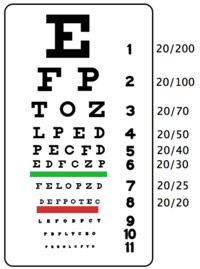
Vision or visual acuity is tested by reading a Snellen eye chart at a distance of 20 feet. This chart consists of random letters of different sizes. The letters for normal vision (20/20) are 3/8 inches tall. If you have 20/20 vision, it means that when you stand 20 feet away from the chart you can see what a normal human being can see with no visual correction. In other words, if you have 20/20 vision your vision is normal -- a majority of people in the population can see what you can see at 20 feet.
If you have 20/40 vision, it means that when you stand 20 feet away from the chart you can only see what a normal human can see when standing 40 feet from the chart. That is, if there is a normal person standing 40 feet away from the chart, and you are standing only 20 feet away from the chart, you and the normal person can see the same detail. 20/100 means that when you stand 20 feet from the chart you can only see what a normal person standing 100 feet away can see. 20/200 is the cutoff for legal blindness in the United States.
You can also have vision that is better than the norm. A person with 20/10 vision can see at 20 feet what a normal person can see when standing 10 feet away from the chart.
If you have 20/40 vision, it means that when you stand 20 feet away from the chart you can only see what a normal human can see when standing 40 feet from the chart. That is, if there is a normal person standing 40 feet away from the chart, and you are standing only 20 feet away from the chart, you and the normal person can see the same detail. 20/100 means that when you stand 20 feet from the chart you can only see what a normal person standing 100 feet away can see. 20/200 is the cutoff for legal blindness in the United States.
You can also have vision that is better than the norm. A person with 20/10 vision can see at 20 feet what a normal person can see when standing 10 feet away from the chart.
Glossary
Addition (Add Power)
In multifocal lenses, the part of the lens that has correction for near vision.
Anti-Reflective Coating
A thin layer of material applied to the surface of a lens for the purpose of reducing unwanted reflections from the lens and increasing the amount of light that passes through to the eye. AR coated lenses reduce eyestrain and are one of the best remedies for glare caused by headlights at night.
Astigmatism
A common disorder when the cornea is oblong rather than spherical in shape. This irregular curvature prevents light from focusing properly on the retina. As a result, objects that are close or at a distance may appear blurry or doubled. Astigmatism can cause headaches, eye strain and fatigue to blurred or distorted vision.
Axis
In correcting for astigmatism, the cylinder power determines how much correction is needed and the axis determines at what degree to place it.
Base Curve
The front curve or surface on a lens.
Bifocal Lens
A lens used for correcting two visual fields. Generally one for distance vision, and one for near vision.
Bridge
The area of the frame front between the lenses that rests on the patients nose.
Bridge Size
The shortest horizontal distance between lenses (DBL), measured in millimeters.
Cataract
A condition characterized by clouding in the natural lens of the eye. The cause is usually unknown but can result from exposure to ultraviolet light, injury, heredity, disease and advancing age. Some medical treatments include surgical replacement of the natural lens with an artificial lens.
Cornea
The surface portion of the eye through which light rays first enter and are bent or refracted.
Crystalline Lens
The portion of the eye that further refracts the light and focuses it on the retina.
Cylinder Power
In correcting for astigmatism, the cylinder power determines how much correction is needed and the axis determines at what degree to place it.
DBC
Abbreviation for distance between centers.
DBL
Abbreviation for distance between lenses.
Depth Perception
The appearance of depth is created when both eyes focus on the same plane simultaneously.
Eyeglasses
A term commonly used to describe an ophthalmic frame with lenses inserted.
Eyewire
The section of the frame surrounding each lens.
Farsightedness
See Hyperopia.
Glaucoma
An eye disease characterized by an increase in pressure inside the eye capable of causing damage to the optic nerve. Left untreated, this condition can lead to blindness. Glaucoma is usually treated with eye drops and medications. Severe cases may require surgical correction.
HD Digital Lenses
Lenses that are processed creating the most natural vision available. These lenses are digitally manufactured with computer-controlled surfacing equipment to give you edge to edge clarity throughout the lens. These lenses are thinner, lighter, and deliver clearer, sharper vision. These lenses are available in progressive and single vision.
Hyperopia (farsightedness)
Occurs when the cornea is too flat or irregularly shaped (too short), causing nearby objects to appear blurry while objects in the distance are clear. Common signs of hyperopia include difficulty maintaining a clear focus on nearby objects, and eye strain or headache after close work.
I.P.D.
Abbreviation for interpupillary distance.
Index of Refraction
A measure of the ability of a lens to refract a ray of light of a given wavelength. The higher the index the thinner the lens.
Intermediate Zone
The area in a multifocal lens that is designed to correct vision at ranges intermediate to distance and near objects.
Interpupillary Distance
The distance from the center of the pupil of one eye to the center of the pupil of the other eye.
Lens Blank
An unfinished lens that is manufactured to fit a customer's prescription.
Lensometer
An instrument used to measure the power of an individual's current prescription eyeglasses.
Multifocal Lens
A lens designed with two or more power zones or viewing ranges (e.g., a bifocal with two, a trifocal with three, a progressive with many).
Myopia (nearsightedness)
A vision condition affecting nearly a third of people in the United States. A myopic eye focuses properly on nearby objects, but distant objects appear blurry. This imbalance typically occurs because the cornea either has an oblong shape (too long) or is excessively curved, so that only some of the light entering the eye focuses on the retina. The most common symptom is difficulty seeing objects in the distance, for example a chalkboard or television screen.
Nearsightedness
See Myopia.
O.D.
Oculus dexter. Latin abbreviation for right eye.
O.D.
Doctor of Optometry, or Optometrist.
O.S.
Oculus sinister. Latin abbreviation for left eye.
O.U.
Oculi uterque. Latin abbreviation for both eyes, right and left.
Ophthalmologist
A medical doctor M.D. or doctor of osteopathy D.O. specializing in the eye who is trained to examine, diagnose, treat and manage diseases of the visual system, including all types of surgical procedures. Requires completion of a four-year undergraduate program, four years of medical school and a minimum of three years in ophthalmology training.
Optical Center
The spot on the eyeglass lens where light passes through without bending (refracting). This point is normally placed in front of the pupil.
Optician
A professional trained to fit, fabricate and dispense eyewear based on the specifications provided by an optometrist or ophthalmologist. He/She is an expert in optics and have the knowledge of how lenses work and interact with your eyes. An optician is to an eye doctor as a pharmacist is to a doctor.
Optometrist
A primary health care professional that can diagnose, manage and treat conditions and diseases of the human eye and visual system, as required by state law. They do not perform eye surgery.
P.D.
Abbreviation for interpupillary distance.
Photochromic Lenses
A lens manufactured to be sensitive to ultraviolet light (sunlight). These lens darken when the wearer is in sunlight, but return to clear indoors.
Polarized Lenses
Tinted lenses specifically designed to reduce haze and glare while increasing visibility. These lenses block out virtually all Ultra Violet Rays.
Polycarbonate Lenses
Lenses made from a synthetic, light weight material that are very impact-resistant. They are also one of the thinnest materials used in eyewear.
Presbyopia
A condition given where the crystalline lenses in the eye lose elasticity and do not change shape as easily as they should. Presbyopia causes people to have increased difficulty with near vision and reading, and is corrected with multifocals.
Prescribed Prism
An effect produced by de-centering a lens so that the optical center is not in front of the wearer's pupils.
Progressives Lenses
A seamless Multifocal lens that progressively adds power in the transitional zone, or corridor, between the upper distance portion of the lens and the lower near segment.
Pupil
In the eye, a round hole formed by the iris that regulates what light passes into the eye. Light must pass through the pupil to get to the retina.
Pupillary Distance
The distance, in millimeters, from one pupil center to the other. PD measurement is used to ensure proper lens placement.
Pupilometer
A machine that measures the precise pupillary distance.
Refractions
Eye examinations conducted by an ophthalmologist or an optometrist to determine appropriate eyewear prescriptions.
Refractive Index (RI)
The ability of the lens to bend light. Materials that bend the most light have the highest refractive index.
Refractive Power
The ability of a lens or an optical surface to produce a change in the convergence or divergence of a beam of light , usually expressed in diopters.
Retina
Part of the eye that picks up images and transmits them to the brain through the optic nerve.
Segment
Segments of the eyeglass lenses that are used for near vision bifocals. The surrounding larger portion of the lens is used for distance vision.
Seg Height
The distance from the lowest portion of the eyewire to the top horizontal line of the Segment.
Sphere Power
Sphere Power is the first number in a prescription for corrective lenses that indicates the type and amount of correction.
Single Vision Lens
A lens designed to correct one distance, near or far. Used to correct myopia, hyperopia, and astigmatism.
Transition Zone
The area of progressive eyeglass lenses where the distance vision prescription gradually changes into the near-vision prescription.
Trifocals
Eyeglass lenses having three areas of viewing, each with its own focal power. Usually, the upper portion is for distance viewing, the lower for near and the middle for the distance in between.
Trunk Show
An event in which LensMasters invites sales representatives from the top frame designers to showcase their entire line of eyeglasses and sunglasses from their collection. In many cases it allows the eyewear to be previewed and/or purchased before it is made available to the public. These are fun events and allow patients additional savings and prize opportunities.
Ultra Violet Protection
The degree to which a lens or its coating protects the eye from the sun's harmful ultra violet rays.
In multifocal lenses, the part of the lens that has correction for near vision.
Anti-Reflective Coating
A thin layer of material applied to the surface of a lens for the purpose of reducing unwanted reflections from the lens and increasing the amount of light that passes through to the eye. AR coated lenses reduce eyestrain and are one of the best remedies for glare caused by headlights at night.
Astigmatism
A common disorder when the cornea is oblong rather than spherical in shape. This irregular curvature prevents light from focusing properly on the retina. As a result, objects that are close or at a distance may appear blurry or doubled. Astigmatism can cause headaches, eye strain and fatigue to blurred or distorted vision.
Axis
In correcting for astigmatism, the cylinder power determines how much correction is needed and the axis determines at what degree to place it.
Base Curve
The front curve or surface on a lens.
Bifocal Lens
A lens used for correcting two visual fields. Generally one for distance vision, and one for near vision.
Bridge
The area of the frame front between the lenses that rests on the patients nose.
Bridge Size
The shortest horizontal distance between lenses (DBL), measured in millimeters.
Cataract
A condition characterized by clouding in the natural lens of the eye. The cause is usually unknown but can result from exposure to ultraviolet light, injury, heredity, disease and advancing age. Some medical treatments include surgical replacement of the natural lens with an artificial lens.
Cornea
The surface portion of the eye through which light rays first enter and are bent or refracted.
Crystalline Lens
The portion of the eye that further refracts the light and focuses it on the retina.
Cylinder Power
In correcting for astigmatism, the cylinder power determines how much correction is needed and the axis determines at what degree to place it.
DBC
Abbreviation for distance between centers.
DBL
Abbreviation for distance between lenses.
Depth Perception
The appearance of depth is created when both eyes focus on the same plane simultaneously.
Eyeglasses
A term commonly used to describe an ophthalmic frame with lenses inserted.
Eyewire
The section of the frame surrounding each lens.
Farsightedness
See Hyperopia.
Glaucoma
An eye disease characterized by an increase in pressure inside the eye capable of causing damage to the optic nerve. Left untreated, this condition can lead to blindness. Glaucoma is usually treated with eye drops and medications. Severe cases may require surgical correction.
HD Digital Lenses
Lenses that are processed creating the most natural vision available. These lenses are digitally manufactured with computer-controlled surfacing equipment to give you edge to edge clarity throughout the lens. These lenses are thinner, lighter, and deliver clearer, sharper vision. These lenses are available in progressive and single vision.
Hyperopia (farsightedness)
Occurs when the cornea is too flat or irregularly shaped (too short), causing nearby objects to appear blurry while objects in the distance are clear. Common signs of hyperopia include difficulty maintaining a clear focus on nearby objects, and eye strain or headache after close work.
I.P.D.
Abbreviation for interpupillary distance.
Index of Refraction
A measure of the ability of a lens to refract a ray of light of a given wavelength. The higher the index the thinner the lens.
Intermediate Zone
The area in a multifocal lens that is designed to correct vision at ranges intermediate to distance and near objects.
Interpupillary Distance
The distance from the center of the pupil of one eye to the center of the pupil of the other eye.
Lens Blank
An unfinished lens that is manufactured to fit a customer's prescription.
Lensometer
An instrument used to measure the power of an individual's current prescription eyeglasses.
Multifocal Lens
A lens designed with two or more power zones or viewing ranges (e.g., a bifocal with two, a trifocal with three, a progressive with many).
Myopia (nearsightedness)
A vision condition affecting nearly a third of people in the United States. A myopic eye focuses properly on nearby objects, but distant objects appear blurry. This imbalance typically occurs because the cornea either has an oblong shape (too long) or is excessively curved, so that only some of the light entering the eye focuses on the retina. The most common symptom is difficulty seeing objects in the distance, for example a chalkboard or television screen.
Nearsightedness
See Myopia.
O.D.
Oculus dexter. Latin abbreviation for right eye.
O.D.
Doctor of Optometry, or Optometrist.
O.S.
Oculus sinister. Latin abbreviation for left eye.
O.U.
Oculi uterque. Latin abbreviation for both eyes, right and left.
Ophthalmologist
A medical doctor M.D. or doctor of osteopathy D.O. specializing in the eye who is trained to examine, diagnose, treat and manage diseases of the visual system, including all types of surgical procedures. Requires completion of a four-year undergraduate program, four years of medical school and a minimum of three years in ophthalmology training.
Optical Center
The spot on the eyeglass lens where light passes through without bending (refracting). This point is normally placed in front of the pupil.
Optician
A professional trained to fit, fabricate and dispense eyewear based on the specifications provided by an optometrist or ophthalmologist. He/She is an expert in optics and have the knowledge of how lenses work and interact with your eyes. An optician is to an eye doctor as a pharmacist is to a doctor.
Optometrist
A primary health care professional that can diagnose, manage and treat conditions and diseases of the human eye and visual system, as required by state law. They do not perform eye surgery.
P.D.
Abbreviation for interpupillary distance.
Photochromic Lenses
A lens manufactured to be sensitive to ultraviolet light (sunlight). These lens darken when the wearer is in sunlight, but return to clear indoors.
Polarized Lenses
Tinted lenses specifically designed to reduce haze and glare while increasing visibility. These lenses block out virtually all Ultra Violet Rays.
Polycarbonate Lenses
Lenses made from a synthetic, light weight material that are very impact-resistant. They are also one of the thinnest materials used in eyewear.
Presbyopia
A condition given where the crystalline lenses in the eye lose elasticity and do not change shape as easily as they should. Presbyopia causes people to have increased difficulty with near vision and reading, and is corrected with multifocals.
Prescribed Prism
An effect produced by de-centering a lens so that the optical center is not in front of the wearer's pupils.
Progressives Lenses
A seamless Multifocal lens that progressively adds power in the transitional zone, or corridor, between the upper distance portion of the lens and the lower near segment.
Pupil
In the eye, a round hole formed by the iris that regulates what light passes into the eye. Light must pass through the pupil to get to the retina.
Pupillary Distance
The distance, in millimeters, from one pupil center to the other. PD measurement is used to ensure proper lens placement.
Pupilometer
A machine that measures the precise pupillary distance.
Refractions
Eye examinations conducted by an ophthalmologist or an optometrist to determine appropriate eyewear prescriptions.
Refractive Index (RI)
The ability of the lens to bend light. Materials that bend the most light have the highest refractive index.
Refractive Power
The ability of a lens or an optical surface to produce a change in the convergence or divergence of a beam of light , usually expressed in diopters.
Retina
Part of the eye that picks up images and transmits them to the brain through the optic nerve.
Segment
Segments of the eyeglass lenses that are used for near vision bifocals. The surrounding larger portion of the lens is used for distance vision.
Seg Height
The distance from the lowest portion of the eyewire to the top horizontal line of the Segment.
Sphere Power
Sphere Power is the first number in a prescription for corrective lenses that indicates the type and amount of correction.
Single Vision Lens
A lens designed to correct one distance, near or far. Used to correct myopia, hyperopia, and astigmatism.
Transition Zone
The area of progressive eyeglass lenses where the distance vision prescription gradually changes into the near-vision prescription.
Trifocals
Eyeglass lenses having three areas of viewing, each with its own focal power. Usually, the upper portion is for distance viewing, the lower for near and the middle for the distance in between.
Trunk Show
An event in which LensMasters invites sales representatives from the top frame designers to showcase their entire line of eyeglasses and sunglasses from their collection. In many cases it allows the eyewear to be previewed and/or purchased before it is made available to the public. These are fun events and allow patients additional savings and prize opportunities.
Ultra Violet Protection
The degree to which a lens or its coating protects the eye from the sun's harmful ultra violet rays.

